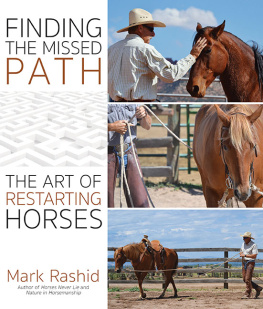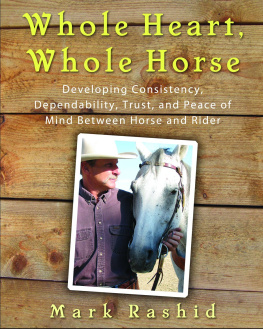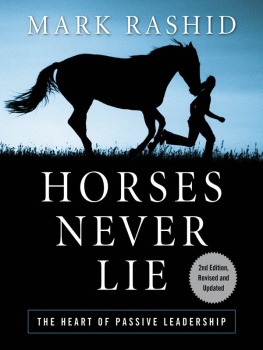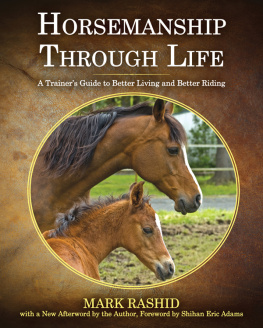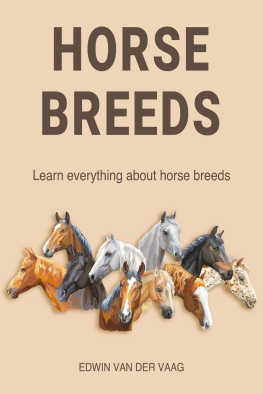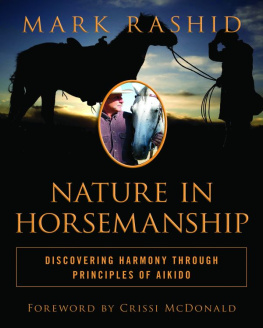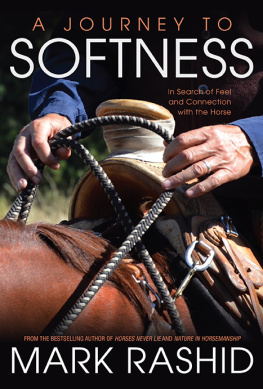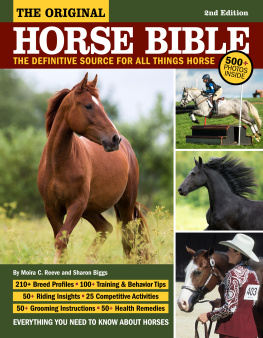A Good Horse Is
Never a Bad Color
Tales of Training Through Communication and Trust,
2nd Edition, Revised and Updated
Illustrations by Herb Mignery

Copyright 2011 by Mark Rashid
All Rights Reserved. No part of this book may be reproduced in any manner without the express written consent of the publisher, except in the case of brief excerpts in critical reviews or articles. All inquiries should be addressed to Skyhorse Publishing, 307 West 36th Street, 11th Floor, New York, NY 10018.
Skyhorse Publishing books may be purchased in bulk at special discounts for sales promotion, corporate gifts, fund-raising, or educational purposes. Special editions can also be created to specifications. For details, contact the Special Sales Department, Skyhorse Publishing, 307 West 36th Street, 11th Floor, New York, NY 10018 or .
Skyhorse and Skyhorse Publishing are registered trademarks of Skyhorse Publishing, Inc., a Delaware corporation.
www.skyhorsepublishing.com
10 9 8 7 6 5 4 3 2 1
Library of Congress Cataloging-in-Publication Data available on file. ISBN 978-1-61608-239-0
Printed in China
In memory of Robert J. Wrangler Rob Kralovec, my friend.
March 5, 1959February 11, 1995
One of the truly great things about working for a horse publication is being able to work with, and absorb, the ideas and philosophies of some of the most gifted trainers in the country. In editing their articles for publication, I get to climb into their brains for a while and hang outalways directly applying some aspect of their teaching to something Im currently going through, or have experienced in the past, with one of my own horses.
Somewhere in my filing cabinet is a picture of Mark Rashid, walking toward the camera, shoulder to shoulder with an unrestrained horse. The overall impression this snapshot gives is one of equal partners who have just finished working for the day and are headed home for a beer and a bite to eat. Such is a relationship that is based on mutual respect and trust. It focuses not as much on performance as on a horses understanding of what is being asked of him and his willingness to accept that request.
For the most part, in this book as well as in his first one, Marks equine clientele are not the coddled, push-button, want-for-nothing-in-their-lives, pedigreed show stock that most trainers focus on. Rather, through his work with the Colorado Horse Rescue and similar facilities, Mark seems to draw in more than his share of damaged and wary equine goods. These are horses that, as he states in the book, are not so much physically abused as they are mentally spoiled. (Funny, we seem to use that word only when we mean over-indulged.) In fact, if these horses were humans, Mark would be more of a social worker/psychologist than a teacher, running a halfway house for the criminally mistrained and misunderstood.
Take the title chapter of A Good Horse Is Never a Bad Color, for example. In it, Mark tells of his work with horses of the Arabian, paint, and appaloosa persuasions. While their training problems were considerable and quite genuine, each also suffered, to some degree, from prejudiced and stereotypical thinking regarding their breed in general. Who among us, who has owned a horse of one of these breeds, has not had to endure censure and I-told-you-sos across the back fence from self-righteous, opinionated horse snobs?
It is Marks contention that, in most cases of bad equine behavior, it is the humans poor understanding of a particular breed or horse that has caused the problem to develop.
Quite a while back, I saw something listed in the local want-ads that I felt warranted checking out. It read: Six-year-old Hanoverian gelding for sale. Athletic and hauls well. $1800. Although I wasnt in the market for another horse, my sister was. Being a three-day-eventer, she is particularly partial to the German warmblood breed known as the Hanoverian. These animals are in great demand as dressage and jumping prospects, due to their large but athletic frame and pleasant disposition. What, I idly wondered, was a member of such an exotic breed doing way out here in cowboy country?
The gelding was saddled and waiting for me when I arrived. A gorgeous but sweating dapple-gray, standing just shy of sixteen hands, he was smaller and somewhat more refined than the Hanoverians I was used to seeing, but beautifully conformed and in good flesh. I was informed that he had been bred and trained at a local thoroughbred farm, then sold when he failed to grow to Olympic proportions. The current owner had bought him as a weekend roping horse, but said that he couldnt give the gelding the exercise he seemed to require. I tried to imagine this powerhouse before me standing idly at one end of the roping arena, waiting perhaps all day for his one or two chances to move out.
I moved to the horse, speaking to him as I stroked him, in preparation for taking a test ride. The horse gave no indication that he heard or felt me. He stood stoically still, his eyes focused on a distant mountain. The owner said he had warmed him up by lunging him a while. Normally, I ask to see an owner ride a horse first, so I can watch how the animal behaves under saddle. However, I happened to notice the cast on the owners arm and sensed a bit of reluctance on his part to mount the animal. So, without further ado, I set a foot in the stirrup and prepared to swing my leg over.
No sooner had my weight come to rest in the saddle than several things happened in quick succession. First, I felt every muscle in the geldings back contract into what felt like a huge fist with a saddle strapped to it. At the same time, I was aware of a staccato, dancing action from all four of his feet. Third, I got a good look at the heavy steel railing of the round pen we were in. What had seemed to be an adequately-sized space for riding was now rapidly closing in, until it appeared to be only about ten feet in diameter. Various bells, whistles, and alarms, as well as flashing red railroad lights, were going off inside my head. I swung back down to stand firmly before the owner and said, Now, maybe you should tell me something about this horse.
The owner proceeded to tell me how the horse had just up and soured all of a sudden. After the particularly violent episode that broke his arm, he had started actively campaigning for a new owner. I just want my money back out of him, thats all, he assured me.
Needless to say, I passed on the horse. At the time, I racked my brain for someone to send that poor animal to for retraining (or at least a better attitude). It was quite obvious that his problems stemmed from human error. Had I known about Mark Rashid back then, I would have bought the gelding and hauled him up to Colorado myself.
I happened to run into the owner of the Hanoverian many months later, and learned what became of him. A bunch of local cowhands hauled the horse out into the desert and took turns trying to buck him out, which they couldnt seem to accomplish. Then one of the hands took him down to Phoenix and tried to sell him to a rodeo livestock dealer, as a potential bucking horse. Word had it that, when he couldnt get enough money for him at the rodeo, the kid just decided to chow him at a local auction.
Sad stories such as this one point out the fact that we still have a lot to learn about the magnificent animal we call the horse. All of us need to give thanks for trainers, like Mark Rashid, who have devoted their lives to helping us gain that knowledge and understanding. The sooner we all get educated, the better the horses of this world will fare.
Indeed, a good horse is never a bad color (except maybe after a hard rain and a good roll in the paddock). And you can bet that, hidden inside every supposed problem horse, there is a good one just waiting to come out.
Next page

